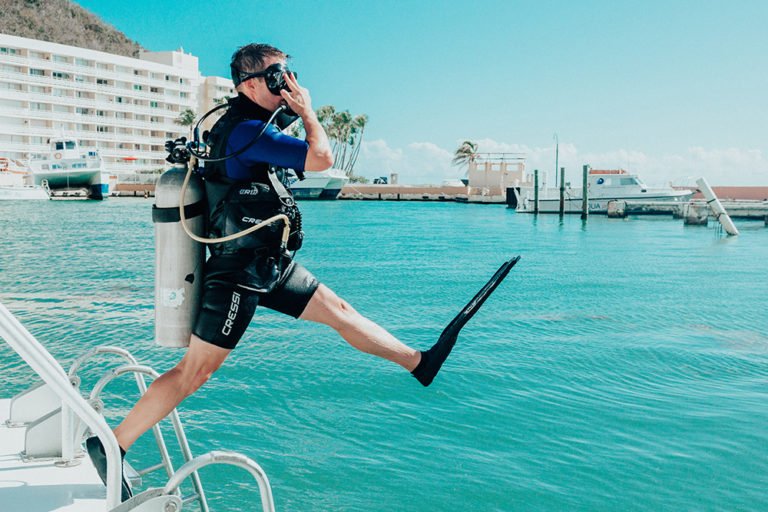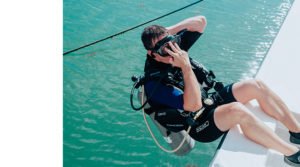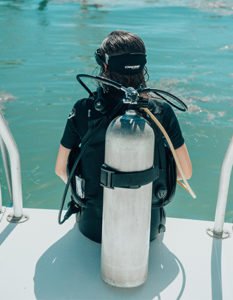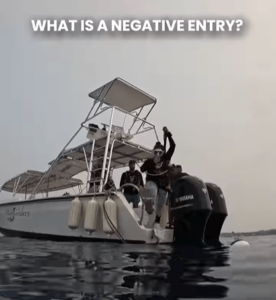Different Entry Types for Scuba Diving

Scuba diving offers a thrilling way to explore the underwater world, but before you can immerse yourself in the beauty beneath the surface, you need to enter the water safely and efficiently. There are several entry techniques used by divers, each suited to different environments and situations. Understanding these entry types ensures you can begin your dive smoothly and enjoy the underwater adventure that awaits. Here, we delve into the various entry types for scuba diving, explaining when and how to use each one.
Giant Stride Entry

Description: The giant stride entry is one of the most common techniques used when entering the water from a boat or a dock.
How to Perform:
- Fully gear up and stand at the edge of the platform with your fins hanging over the side.
- Inflate your BCD (Buoyancy Control Device) partially.
- Hold your mask and regulator with one hand and place the other hand on your weight belt or BCD.
- Take a large step forward, extending your leading leg out as if you are stepping over a large gap.
- Once in the water, signal to the boat crew or your buddy that you are okay.
Best Used: For entries from boats, docks, or piers where the drop is at least a few feet above the water.
Back Roll Entry

Description: The back roll entry is another popular method, especially used from small boats, inflatable boats, or when diving from a low platform.
How to Perform:
- Sit on the edge of the boat or platform with your back facing the water.
- Fully gear up and place your fins over the side.
- Hold your mask and regulator in place with one hand and secure your weight belt or BCD with the other.
- Tuck your chin to your chest and lean back, allowing gravity to roll you into the water.
- Once in the water, signal to the boat crew or your buddy that you are okay.
Best Used: For entries from small boats, Zodiacs, or low platforms close to the water’s surface.
Seated Entry

Description: The seated entry is a gentle method suitable for entering the water from a low platform, shore, or poolside.
How to Perform:
- Sit on the edge of the platform with your feet in the water.
- Fully gear up and ensure your fins are securely in place.
- Slide into the water gently, keeping one hand on your mask and regulator.
- Once in the water, adjust your equipment as necessary and signal to your buddy that you are okay.
Best Used: For shore entries, pool dives, or any low platform where a gentle entry is preferred.
Shore Entry

Description: The shore entry involves walking into the water from the beach or shoreline, often through surf or across rocky terrain.
How to Perform:
- Fully gear up and ensure your fins are securely in place but not on your feet yet.
- Walk into the water until it’s deep enough to put on your fins comfortably.
- Inflate your BCD for buoyancy and put on your fins.
- Once ready, swim out to your descent point.
- Signal to your buddy that you are ready to descend.
Best Used: For beach dives, lake entries, or any dive starting from the shore.
Negative Entry

Description: The negative entry is a technique used when you need to descend quickly, often in strong currents or when diving with a group.
How to Perform:
- Fully gear up and ensure your fins are securely in place.
- Deflate your BCD completely before entering the water.
- Use a giant stride or back roll entry.
- Upon entering the water, immediately begin your descent by swimming down, equalizing as you go.
Best Used: For dives in strong currents, group descents, or when a rapid descent is necessary.
Choosing the right entry technique for scuba diving depends on the dive site, water conditions, and your comfort level. Whether you’re making a giant stride from a boat, rolling back into the water from a small craft, or walking in from the shore, mastering these entry methods ensures a safe and smooth start to your dive. Always remember to signal your buddy or boat crew once you’re in the water to confirm you’re okay. Happy diving!
